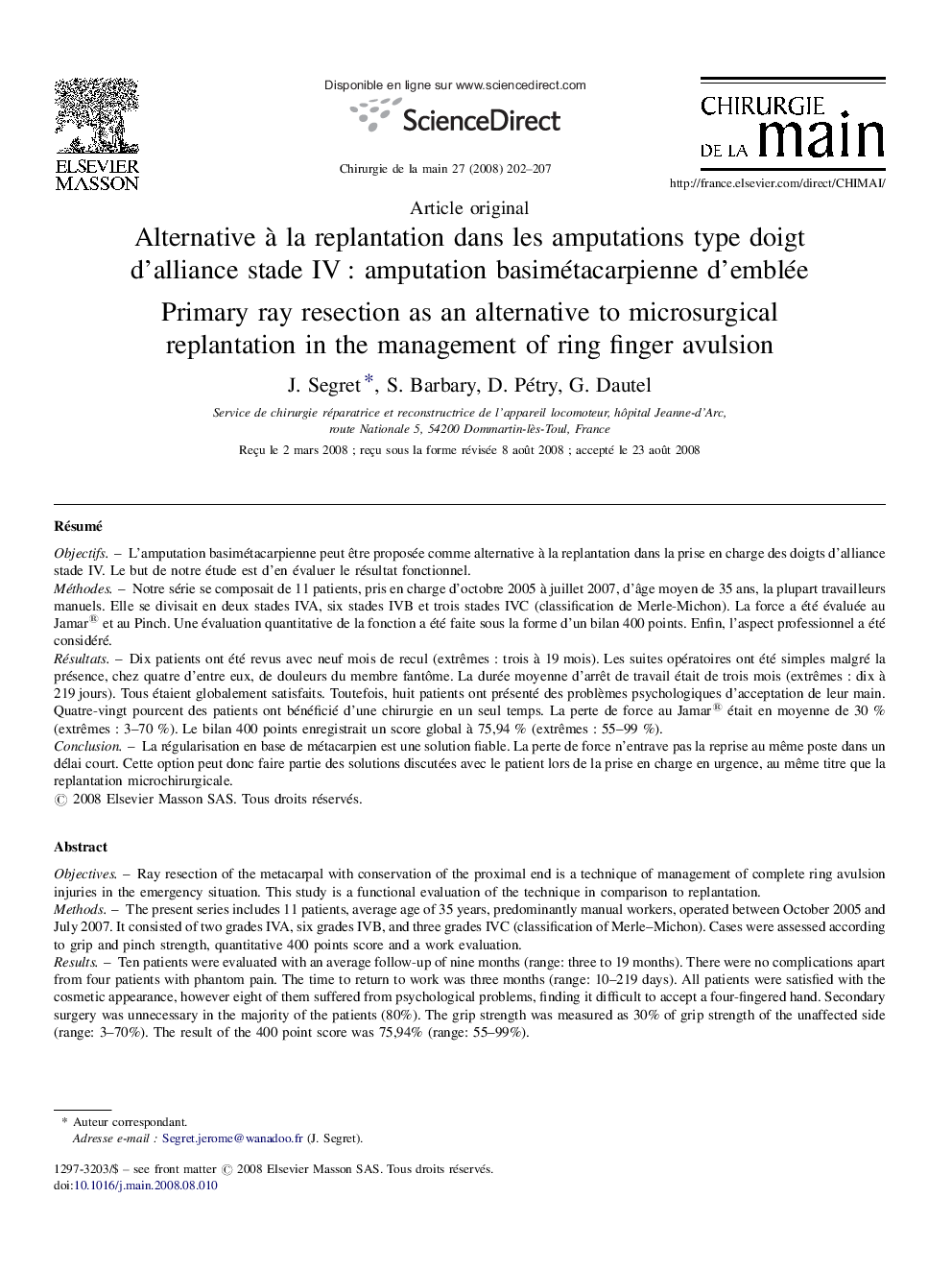| Article ID | Journal | Published Year | Pages | File Type |
|---|---|---|---|---|
| 4049802 | Chirurgie de la Main | 2008 | 6 Pages |
RésuméObjectifsL’amputation basimétacarpienne peut être proposée comme alternative à la replantation dans la prise en charge des doigts d’alliance stade IV. Le but de notre étude est d’en évaluer le résultat fonctionnel.MéthodesNotre série se composait de 11 patients, pris en charge d’octobre 2005 à juillet 2007, d’âge moyen de 35 ans, la plupart travailleurs manuels. Elle se divisait en deux stades IVA, six stades IVB et trois stades IVC (classification de Merle-Michon). La force a été évaluée au Jamar® et au Pinch. Une évaluation quantitative de la fonction a été faite sous la forme d’un bilan 400 points. Enfin, l’aspect professionnel a été considéré.RésultatsDix patients ont été revus avec neuf mois de recul (extrêmes : trois à 19 mois). Les suites opératoires ont été simples malgré la présence, chez quatre d’entre eux, de douleurs du membre fantôme. La durée moyenne d’arrêt de travail était de trois mois (extrêmes : dix à 219 jours). Tous étaient globalement satisfaits. Toutefois, huit patients ont présenté des problèmes psychologiques d’acceptation de leur main. Quatre-vingt pourcent des patients ont bénéficié d’une chirurgie en un seul temps. La perte de force au Jamar® était en moyenne de 30 % (extrêmes : 3–70 %). Le bilan 400 points enregistrait un score global à 75,94 % (extrêmes : 55–99 %).ConclusionLa régularisation en base de métacarpien est une solution fiable. La perte de force n’entrave pas la reprise au même poste dans un délai court. Cette option peut donc faire partie des solutions discutées avec le patient lors de la prise en charge en urgence, au même titre que la replantation microchirurgicale.
ObjectivesRay resection of the metacarpal with conservation of the proximal end is a technique of management of complete ring avulsion injuries in the emergency situation. This study is a functional evaluation of the technique in comparison to replantation.MethodsThe present series includes 11 patients, average age of 35 years, predominantly manual workers, operated between October 2005 and July 2007. It consisted of two grades IVA, six grades IVB, and three grades IVC (classification of Merle–Michon). Cases were assessed according to grip and pinch strength, quantitative 400 points score and a work evaluation.ResultsTen patients were evaluated with an average follow-up of nine months (range: three to 19 months). There were no complications apart from four patients with phantom pain. The time to return to work was three months (range: 10–219 days). All patients were satisfied with the cosmetic appearance, however eight of them suffered from psychological problems, finding it difficult to accept a four-fingered hand. Secondary surgery was unnecessary in the majority of the patients (80%). The grip strength was measured as 30% of grip strength of the unaffected side (range: 3–70%). The result of the 400 point score was 75,94% (range: 55–99%).ConclusionRay resection of the metacarpal with conservation of the proximal end is a reliable procedure. Strength is decreased but this does not stand in the way of a rapid return to previous work. However, the choice of strategy (ray resection versus microsurgical replantation) should be discussed in detail with the patient prior to selecting the appropriate option.
